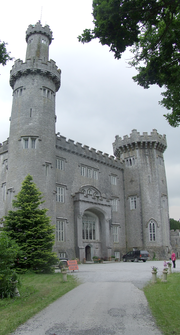
Earl of Charleville
Encyclopedia

Peerage of Ireland
The Peerage of Ireland is the term used for those titles of nobility created by the English and later British monarchs of Ireland in their capacity as Lord or King of Ireland. The creation of such titles came to an end in the 19th century. The ranks of the Irish peerage are Duke, Marquess, Earl,...
. The first creation came in 1758 when Charles Moore, 2nd Baron Moore, was made Earl of Charleville, in the King's County. The title Baron Moore, of Tullamore in the King's County, was created in the Peerage of Ireland in 1715 for his father John Moore, who had previously represented King's County
King's County (Parliament of Ireland constituency)
King's County was a constituency represented in the Irish House of Commons until 1800.-1692–1801:...
in the Irish House of Commons
Irish House of Commons
The Irish House of Commons was the lower house of the Parliament of Ireland, that existed from 1297 until 1800. The upper house was the House of Lords...
. Lord Charleville was childless and the titles became extinct on his death in 1764.
The second creation came in the Peerage of Ireland in 1806 in favour of Charles Bury, 1st Viscount Charleville. He had already been created Baron Tullamore, of Charleville Forest in the King's County, in 1797, and Viscount Charleville, of Charleville Forest in the King's County, in 1800, also in the Peerage of Ireland. Lord Charleville was the grandson of William Bury and the Honourable Jane Moore, daughter of the first Baron Moore and sister of the first Earl of the first creation. His father John Moore had succeeded to the Charleville estates on the death of his maternal uncle in 1764. In 1801 Lord Charleville was elected an Irish Representative Peer
Representative peer
In the United Kingdom, representative peers were those peers elected by the members of the Peerage of Scotland and the Peerage of Ireland to sit in the British House of Lords...
. He was succeeded by his son, the second Earl. He was a Tory politician and sat as an Irish Representative Peer between 1838 and 1851. The title descended from father to son until the early death of his grandson, the fourth Earl, in 1874. The late Earl was succeeded by his uncle, the fifth Earl. The fifth Earl was childless and on his death in 1875 the titles became extinct.
Lady Emily Alfreda Julia Bury, daughter of the third Earl, married Kenneth Howard, son of the Honourable James Howard
James Howard (Whig politician)
The Honourable James Kenneth Howard , was a British Whig politician.A member of the Howard family, he was the fourth son of Thomas Howard, 16th Earl of Suffolk, by the Honourable Elizabeth Jane, daughter of James Dutton, 1st Baron Sherborne...
. She succeeded to the Charleville estates, including Charleville Castle, on the death of her brother the fifth Earl in 1875 and in 1881 she and her husband assumed by Royal license the additional surname of Bury. Their son was the explorer and Conservative
Conservative Party (UK)
The Conservative Party, formally the Conservative and Unionist Party, is a centre-right political party in the United Kingdom that adheres to the philosophies of conservatism and British unionism. It is the largest political party in the UK, and is currently the largest single party in the House...
politician Charles Howard-Bury.
Barons Moore (1715)
- John Moore, 1st Baron Moore (d. 1725)
- Charles Moore, 2nd Baron Moore (1712–1764) (created Earl of Charleville in 1758)
Earls of Charleville; First creation (1758)
- Charles Moore, 1st Earl of Charleville (1712–1764)
Earls of Charleville; Second creation (1806)
- Charles William Bury, 1st Earl of Charleville (1764–1835)
- Charles William Bury, 2nd Earl of Charleville (1801–1851)
- Charles William George Bury, 3rd Earl of Charleville (1822–1859)
- Charles William Francis Bury, 4th Earl of Charleville (1852–1874)
- Alfred Bury, 5th Earl of Charleville (1829–1875)

